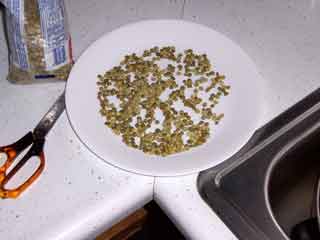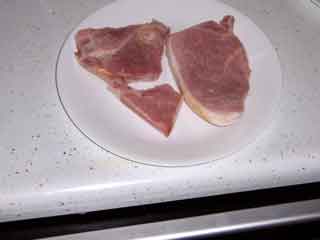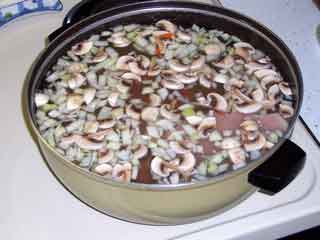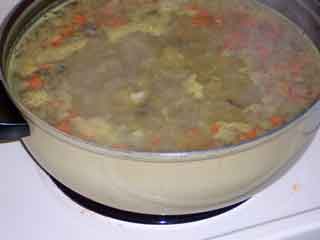Well, if you've got any split green peas left, this is the way to deal with them. First, cook a ham. Feed 23 people (friends, relatives, the local fireman's fund raisers, whatever). Save the ham bone (and all the little tidbits, or big tidbits, of ham meat that didn't get eaten). Freeze them. Wait a few months. Now you're ready to make split pea soup.
here's what you'll need . . .
1 lb (one bag) dried split green peas
1 leftover ham bone
leftover ham meat (or whatever you end up scraping off the bone, if that's all you have)
1 (or 2) smallish carrots, sliced or coarsely chopped
3 - 4 medium potatoes, peeled or not, cubed
1 medium onion, chopped
6 - 12 mushrooms, thick sliced or coarsely chopped (optional if you hate mushrooms)
Tellicherry
thyme
2, 4, 6 qts. water
Here's how you do it.
Get out that old huge Dutch oven, or your 12 (20?) qt. stockpot, or the biggest other bucket you can find to cook in. This is a soup that needs to be made in quantity. This recipe will make about 8 servings (or more, if you're not using it as a main dish!)
Like it says on the bag of peas - pick them over carefully. I've only found three pebbles in 30 years of soup making, but if I had bitten into any one of those three, my Dentist's children would all have gone to Harvard.
Used to be, I’d hang a strainer into a saucepan and slowly pour a few peas from the bag into my other hand. If I didn't see any rocks or other junk, dump into the strainer. Next few peas, and so on . . .
Recently, while picking over beans for a chili, it dawned on me that a white dinner plate would make the whole job a lot easier! So, pour out some legumes of whatever ilk onto the plate and take a good look. Sticks and stones really stand out (I didn’t find any in the peas, but I found several in the beans!)

When you’ve removed any detritus, into the strainer with the clean peas or beans or . . .

Then give the strainer a swirl or five under cold running water. Drain, and toss the peas into the soup pot.

Cover the peas with water to a depth of about two inches, or a little less. Cover the pot and turn the heat to high. As soon as the peas come steamily close to a boil, turn the heat off (on an electric stove, or to barely a flame on a gas stove). You basically want to warm the peas for the next 30 minutes or so.

If you peek, you’ll usually see a white froth on the surface of the water. Not to worry. It’s just loose, surface starch, ‘blooming’ in the hot water. Eventually, the peas will reabsorb some of it and the rest will dissolve in the water.

However, there is a choice to be made here. All starchy, dried legumes have one thing in common – gas, flatulence, the musical toots, you know . . . If you’re among good friends, well, hey, charge on. If someone’s boss is coming for dinner, might I suggest . . .
Add about ½ tsp. of baking soda to the water before it comes to a boil. When the 30 minute ‘warm time’ is done, discard the water and start with fresh water to make the rest of the soup. (Do the same thing with beans or lentils and nobody will be asking you to ‘pass the Beano’ at the dinner table.)
While the peas are tenderizing, whack up the onion, carrots, and mushrooms (if you're using them).

If you've got some separate ham meat leftovers, dice them up into ¼ bite size bits. In this case, you’ll notice that my ham bone is a tad on the tiny side. No matter. Whatever you’ve got is just what you need. This was leftover from a ham steak. I put it in frozen; took it out cooked, and then trimmed the fat off. Made a great soup!

When the peas have been threatened for 30 minutes, add in the ham bone, toss in whatever you chopped up,

and fill the pot with water (well, put in at least 2 quarts; I usually go with 4, or maybe more, because I'd rather cook the soup 'down' to a good texture than have to try to thin it 'up' to a good texture). Crank up the heat, cover the pot, and wait for it to get nearly to a boil.

While waiting, wash your potatoes, and peel them if you must. Slice them in half lengthwise (so you end up with the thinnest halves, not the thickest).

Slice each half lengthwise into three strips. Slice each strip crosswise into 4 or 5 bite sized cubes.

By now (if you've got a really good stove), your soup is bubbling nicely, nearly at the boil. So cool it down again! By tossing in the potatoes. Grind a goodly layer of Tellicherry onto the top, and throw in about 1/3 tsp. of dried thyme (which you, of course, will crumble into the palm of your hand before tossing in!). Cover again. Get bubbling again. Turn down the heat to a bare simmer.

Cook for at least an hour. After 30 minutes, crack the lid to let some steam escape. After an hour, check the texture of your soup. It should be thickening, but still on the thin-ish side. If it reminds you of the LaBrea tar pits, ADD MORE WATER! If it's not sludge yet, taste it. Adjust the seasonings - is it salty enough? Peppery enough? Just that hint of thyme behind the peas? Anything else that your tongue just screams out for? Well, now's the time to add it.
And while you're at it, dredge out that ham bone. Put it on a plate and let it cool for 10 minutes or so. Then scrape every last speck of edible meat off the bone and return the meat to the soup pot. Toss the bone in the garbage.
Cook that soup until it's done - might be another 10 minutes, might be another hour. You want this to be a thick soup - it kind of sloozes out of the ladle, neither splashing, nor requiring a spoon to push it off the ladle. Sloozing, splooshing, you know . . .

Hey, serve it into bowls and dig in. Eat it with corn muffins or rye toast or oyster crackers or Pilot Crackers if you can get them, maybe a salad. Keeps for a month (if you cook it every week!), freezes for a year. Never let a good ham get away . . .!
nice way of presenting the info. thanks
ReplyDelete